Spoiler Warning: This article will reveal many of the secrets of the Age, so if you have not explored it and want to discover what it is about for yourself, do not read this until you are done.
Ahnonay is an Age that was written sometime
in the D'ni century 9300, which was in the early 1700s on the surface. It
was the work of Kādish, a former guild master of the Guild of Writers.
He made it in an attempt to convince visitors that he was the Grower, a person
prophesied in a book called Words that had been written by a prophet who
called himself the Watcher. The Watcher wrote Words in the D'ni year 4500,
or 3157 BC.
I like to say that the Age was Kādish's grand
attempt to prove that sometimes you can fool
all of the people all of the time. The name of the Age literally translates
as "water
root".
In many place names, the word for root seems to imply the source of something,
so it might be possible to translate it as "water source".
The Age itself consists of a hole with water
flowing down on all sides. There are undefined voids above and below that
give it an overall appearance like an hourglass. It is not known
where the water comes from or goes, or whether this is an isolated section
of a much larger world, although that's likely given the limitations D'ni
writers were obliged to follow.
For now, my best guess is that the area containing the Age,
which the DRC called the Cascade, might be located in a subterranean cavern.
If true, that would explain why only the area around Kādish's construction
is lit. The light would be artificial illumination provided by all the lamps
he installed outdoors. Some other possibilities would be that the Cascade
exists on a world that is perpetually covered in clouds that block sunlight
from getting through, or that the planet is tidally locked with its sun so
that it's always night where the cascade is located.
In the following text, asterisks (*) indicate information
that has been confirmed as accurate by Cyan Worlds or which was provided by them for the article. The following text has been read and approved by Cyan Worlds staff.
The Cathedral
Kādish was fascinated by
Words and believed that he could fulfill
the predictions and become the Grower spoken of in its pages. To that end,
he wrote Ahnonay as a means of convincing other D'ni that he
could control time. Specifically, he wanted them to think
he could link them into the past, present, and future.
Kādish created a quest which he called the
Path of the Shell and challenged his guests in the Great Tree Pub to solve
it. The quest tied together three of his properties: the Great Tree Pub,
the Ahnonay Cathedral and Ahnonay itself.
It's probable that Kādish
never told anyone the real name of Ahnonay because he wanted them
to believe that it was Garternay, the D'ni home world. The object of the
Path of the Shell was to get to the Great Tree sculpture that was overlooked
by a balcony in the Pub. As of the Fall of D'ni, no one had ever solved the
puzzle although many had tried.
Back before the founding of D'ni, the Ronay discovered that Garternay was
becoming uninhabitable for reasons that are not clear, although there are
theories that its sun was dying. In Ahnonay, Kādish implied that the
planet was shattered. Since there is no sign of a sun in his destroyed version
of Ahnonay, there may be something to the idea that their sun was dying.
Yeesha strongly identified with Kādish because she believed they had
much in common. She too was attempting to fulfil the prophesies in Words
and she used several of his Ages and buildings in the quests she created
for explorers. Yeesha appropriated the Path of the Shell, and left
clues in the form of numbers scattered around his properties. The numbers
referred to verses in Words. If one put together the right verses, they gave
a clue how to solve a spiral puzzle on the second floor of the Great Tree
Pub. The spiral puzzle had been built by Kādish as part of his version
of the Path, but he didn't give any clues about how to solve it.
 The
DRC called this hall the Cathedral because of its architecture, not
because it had any religious purpose. The
DRC called this hall the Cathedral because of its architecture, not
because it had any religious purpose.
It is a different Age than Ahnonay. D'ni linking had
practical restrictions in how it worked, and one of those restrictions
was that a person couldn't link directly from one place to another
in the same Age. Because of that, Kādish made the Cathedral as a waypoint
for visitors to pass through while visiting the different parts of
Ahnonay.
It's unknown whether there is a world outside the
Cathedral because there is no entrance or exit except by linking book.
The only clue we have about the outside is that it appears to involve
a lake or pond. The building itself rises
out of a pool of water with more water flowing in channels down the
walls. The walking surface is a catwalk that is suspended above the
pool, and is covered by independent arches that cross over it that
are spaced several feet apart from each other.
Note that the gears and four spheres symbol common
in Kādish's properties feature prominently in the decoration of this
hall. You'll be seeing them again. |
Ahnonay
 The
First Sphere: The first sphere was nicknamed "Water
Ahnonay" by explorers. It is supposed to be the Garternay of the past,
when the Ronay lived there. The
First Sphere: The first sphere was nicknamed "Water
Ahnonay" by explorers. It is supposed to be the Garternay of the past,
when the Ronay lived there.
When first built, the sphere was devoid of animal
life. Kādish probably planted the trees we find there today, but
there were no quabs or grass.* |
 The
only living creatures seen in the first sphere are curious little arthropods
called quabs. Quabs are natives of the Age of
Ahnonay who found their way into the sphere in the centuries
since the Fall of D'ni.* The
only living creatures seen in the first sphere are curious little arthropods
called quabs. Quabs are natives of the Age of
Ahnonay who found their way into the sphere in the centuries
since the Fall of D'ni.*
It was previously believed that Kādish placed
them in the sphere, but that turns out to not be true. In fact, having
them there while giving tours to other D’ni
would have made the weight-based rotation trigger of the sphere unpredictable,
and Kadish would not have permitted that.*
The spheres were designed to be sealed spaces, but
time has taken its toll on the machine and left gaps in the outer shells
of the spheres that native wildlife can climb or fall through. The
quabs are one such creature.* |
 In
this picture is the only type of tree
to be found on the land in the sphere. An early explorer dubbed
them "terrose" trees,
from the D'ni word "ter",
meaning tree, and the English word "rose" because of the color of their
leaves. In
this picture is the only type of tree
to be found on the land in the sphere. An early explorer dubbed
them "terrose" trees,
from the D'ni word "ter",
meaning tree, and the English word "rose" because of the color of their
leaves.
There is a possibility that we might know their D'ni name. There is
a
phrase in Words that might describe them. It says "Like
the lelam they grow, expanding in size but lessening in thickness."
Since the tree trunks are thick at the bottom and get thinner as
you look up and the branches and leaves make the overall tree spread
out, they could be a match the description in the quote. This is, of
course, merely a guess. There is no supporting evidence to back it
up.
The trees raise questions. Did Kādish plant them when they were
fully grown? Are they artificial? Did he wait until they matured before
he tuned his weight detection mechanism? If the trees had grown in
the centuries since the Fall of D'ni, then it's reasonable to suppose
that their weight would have increased and jammed up the weight mechanism
so that it would be impossible to operate the machinery as intended.
Another sign that they might be artificial is the lack of fallen leaves.
|
 Ahnonay is not the only place that an explorer can find trees like these. There is a variety with the same characteristics but with green leaves found in the Age of Releeshan. |
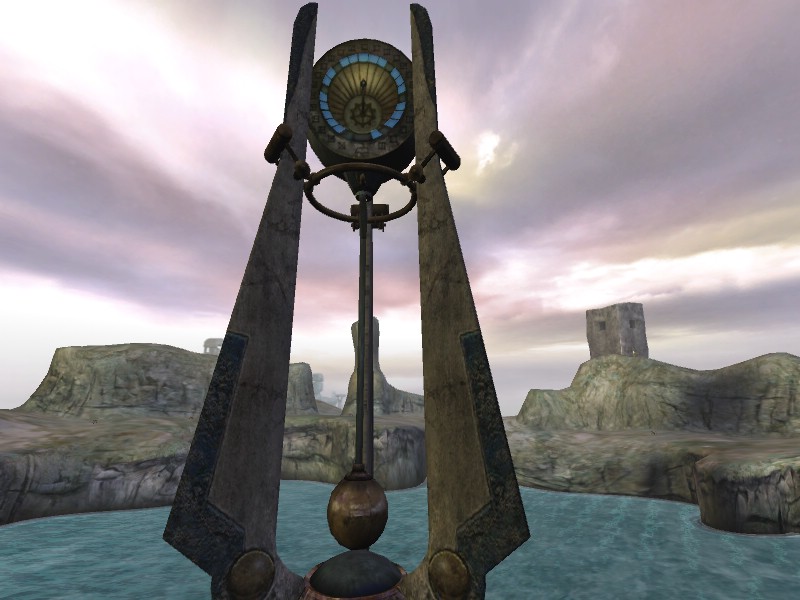 In
the lagoon surrounded by the main island is a clock tower. It also
served a second, secret purpose; it's a sophisticated pressure guage
that Kādish used to check if any extra weight was on either of
the two main islands. In
the lagoon surrounded by the main island is a clock tower. It also
served a second, secret purpose; it's a sophisticated pressure guage
that Kādish used to check if any extra weight was on either of
the two main islands.
The measurement of weight was accomplished by dividing
the islands up into twenty-five sections that radiate outward from
the clock tower. The sections were constructed atop pressure
sensitive plates that are precisely balanced.*
|

On the face of the clock are, in counterclockwise
order, the numbers 1 through 25 and a book symbol. The numbers and
the single hand were normal for this type of D'ni clock. The numbers
represent partavotē,
the D'ni equivalent of hours. There were twenty-five partavotē
to the D'ni day.
It's interesting to note that D'ni clocks ran the
opposite direction from Earth surface clocks. Clockwise to a D'ni would
be counterclockwise to us.
The lighted
sections just inside the numbers told Kādish whether or not there
was any additional weight on any of the radial sections of the islands,
and that weight's direction from the clock tower. |
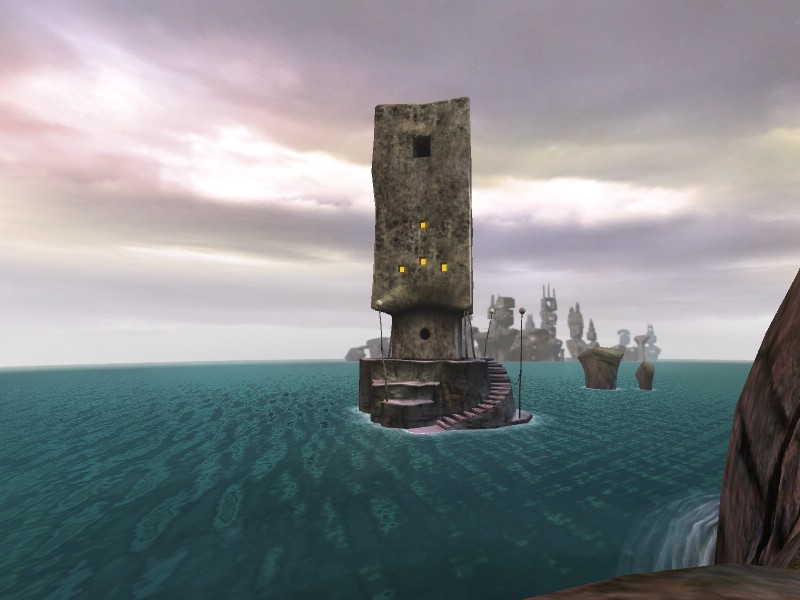 The smaller island held controls for Water Ahnonay,
inside a structure that could not be opened from the outside. Kādish
probably had a private linking book to get to its interior, which Yeesha
would have removed when she set up her version of the Path of the Shell
quest. |
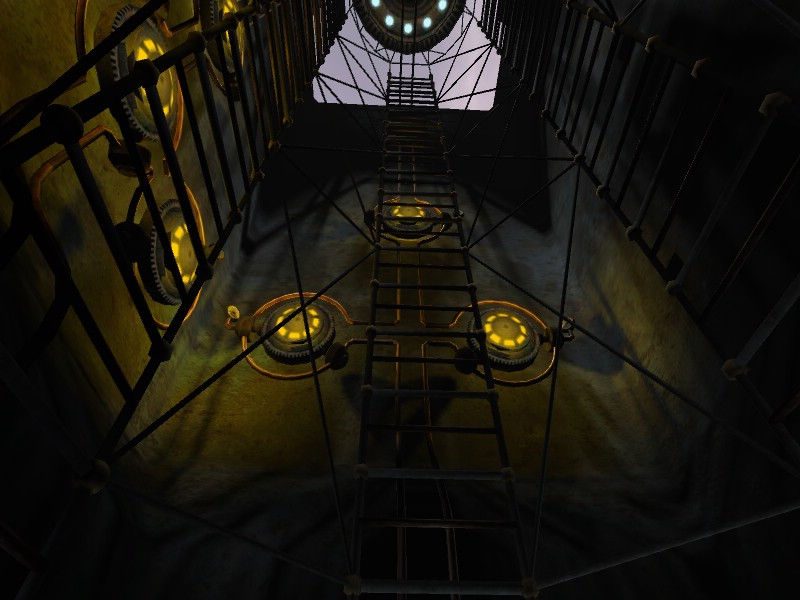 Kādish
designed pumps that created fierce currents to keep people from discovering
the trickery in the sphere. Inside the tower is a large valve that
controls the water currents, allowing him to turn them off and inspect
the sphere when there were no visitors. Kādish
designed pumps that created fierce currents to keep people from discovering
the trickery in the sphere. Inside the tower is a large valve that
controls the water currents, allowing him to turn them off and inspect
the sphere when there were no visitors.
They were always turned on when
he was expecting guests. The last thing Kādish wanted
was for a visitor to get out on the water and see that the "town" in
the distance was made of painted backdrops on mesh screens.
If you look at the picture, notice that there are gauges attached to the mechanisms with the glowing yellow panels on them. If one climbs up the ladders to look at the gauges, a puzzling
observation to make is that they are marked with Arabic numerals and
Roman lettering.
It may be that the originals were not operational when Yeesha
was setting up the Age for her version of the Path of the Shell and
she had to import replacements from the surface, but the truth of that
is not known.

|
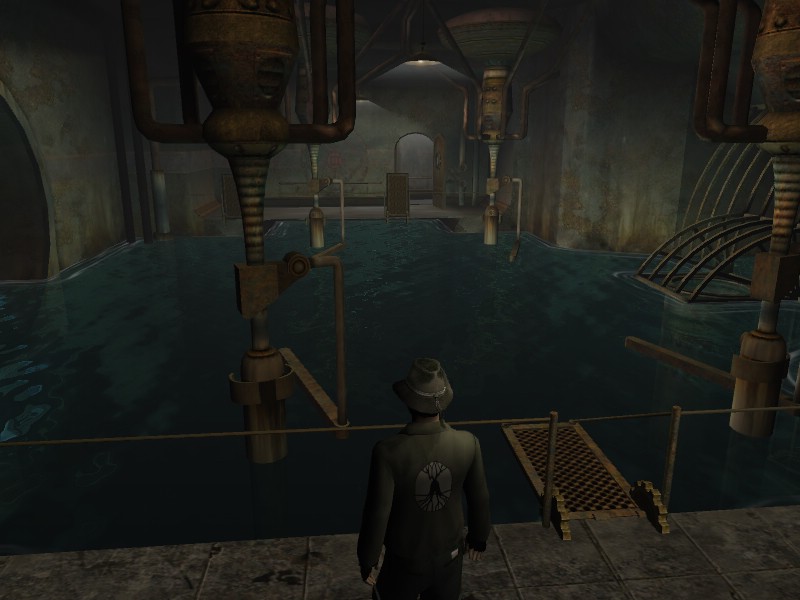 This
room is called Maintenance Room One. There are individual maintenance
rooms for each of the four spheres. This
room is called Maintenance Room One. There are individual maintenance
rooms for each of the four spheres.
The maintenance rooms are in the
shafts that connect the spheres to a central hub. The central hub lies
beyond a pair of sealed hatches, and the spheres rotate around it.
|
 The
Second Sphere: The
Second Sphere: Sphere number two was nicknamed Misty
Ahnonay by explorers. It was meant to represent Garternay in the present.
As with sphere 1, the grass found here in an invasive species from
the outside world. |
 When
you first see this sphere, it contains crystalline structures. Early
explorers dubbed them "ning" trees, because they resemble lightning
bolts in shape. When
you first see this sphere, it contains crystalline structures. Early
explorers dubbed them "ning" trees, because they resemble lightning
bolts in shape.
It was previously thought that they were a deliberate
part of the island, but that was incorrect.
The "ning
trees" are are the result of lightning strikes burning
the sand and creating crystalline, tree-like growths, like an inverted
fulgurite (“lightning
sand”) crystal. This would also explain why they’re
so easy to break; real fulgurite is also incredibly fragile.*
This explains why they are always set in small craters
in the rock of the island and why they don't reform after being broken.
It isn't yet known whether or not the lightning in
this sphere was a deliberate inclusion by Kādish, or if it's the
result of a malfunction after the Fall.
Either way, the crystals were
definitely not part of his plans. Not only do they interfere with the
weight mechanism, having lightning bolts hitting the island is something
Kādish would not have wanted. It would have posed a danger to
himself and his guests from D'ni high society. |
 The
tower in this sphere had little purpose for Kādish except continuity.
While he built the same internal framework inside it, it was bare of
anything else. The
tower in this sphere had little purpose for Kādish except continuity.
While he built the same internal framework inside it, it was bare of
anything else. |
 The
control room in this sphere served no active purpose for Kādish.
Yeesha, on the other hand, used it as a journey station. Kādish
would have accessed it from the hub room. |
 The Third Sphere: The third sphere was nicknamed Space
Ahnonay by explorers. Kādish told visitors that it was Garternay in the future.
He probably also told them that it was his powers as the Grower that were
providing them with air to breathe. The Third Sphere: The third sphere was nicknamed Space
Ahnonay by explorers. Kādish told visitors that it was Garternay in the future.
He probably also told them that it was his powers as the Grower that were
providing them with air to breathe.
There was a lot of PT Barnum in Kādish, and
he must have relied on fast talking to distract visitors from realizing
that there is too little in the way of debris here for an entire planet,
and that for the island to remain more or less intact without a planet
under it would have been impossible.
Grass can also be found in this sphere, and again it is an invasion
of grass native to the Age that found its way inside.
|
 One
of the most prominent features of the sphere are the rings around the
island. One
of the most prominent features of the sphere are the rings around the
island.
|
 The
ring system shown here isn't completely impossible, as outlandish as
it might seem. In the Solar system, there is an object that has been
classed as either a large asteroid or a minor planet named Chariklo
and it has two rings around it. It's 250 km or 160 miles
in diameter, and is the smallest known celestial body to have a ring
system. The
ring system shown here isn't completely impossible, as outlandish as
it might seem. In the Solar system, there is an object that has been
classed as either a large asteroid or a minor planet named Chariklo
and it has two rings around it. It's 250 km or 160 miles
in diameter, and is the smallest known celestial body to have a ring
system.
That's a lot bigger than Sphere 4, but its a celestial object with rings that is smaller than most of the countries on Earth.
|
 The
Fourth Sphere: The interior of the fourth sphere was not
completed before D'ni fell, but it's pretty obvious that was going to
be Kādish's
monument to himself. The
Fourth Sphere: The interior of the fourth sphere was not
completed before D'ni fell, but it's pretty obvious that was going to
be Kādish's
monument to himself.
The platform in this sphere is laid out the same as
the islands in the other spheres, but is covered by gear and sphere
themes that are representative of the Age. Since this interior was
never intended to be seen by guests, Kādish
was quite open with the symbology.
Because it's unfinished, we don't know what it was
intended to look like. However, there's a side platform in the position
of the small island with a bridge leading to it and the framework of
the tower on it. There are many more frameworks and platforms found
in the sphere, so he might have had big plans for it.
There is water
in the bottom of this sphere, although it's shallow and brackish when
compared to the first sphere. The pond scum is undoubtedly an invasion
from outside the sphere. |
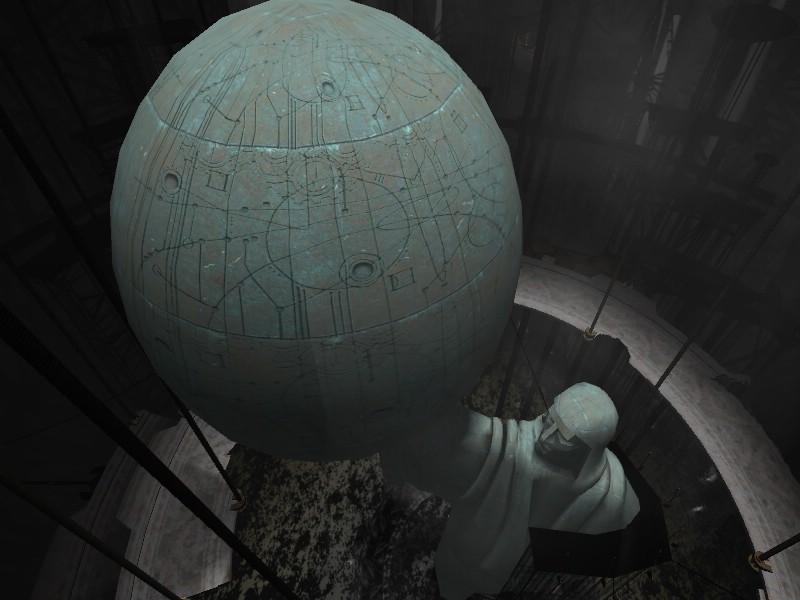 The
statue is, of course, a likeness of Kādish. It's covered in
geometric shapes and numbers. If you look down at the base of the statue,
there are gears and wheels that appear to have been intended to
move the statue in some manner. It probably revolved, but the other gears
appear to have allowed it to tilt back and forth. |
 The
maintenance room for this sphere is the only one that allows access into
the central hub. The
maintenance room for this sphere is the only one that allows access into
the central hub.
There
are actually two hatches, one on each side of the division between
the sphere and the axle. The twin hatches are probably a safety measure to prevent
possible injuries when the machinery is operating. |
 This
is the inside hatch, which closes off the hub room. |
 Other
depictions: In Eder Kēmo, there are bahroglyphs representing
Ahnonay in a seating area near the Puffer garden. One of the unanswered
questions about the glyphs involved a species of fish seen in them. Other
depictions: In Eder Kēmo, there are bahroglyphs representing
Ahnonay in a seating area near the Puffer garden. One of the unanswered
questions about the glyphs involved a species of fish seen in them.
According to DRC records, the fish were nicknamed “firds” (fish-birds) and are
another native species of the Age. They live in the cascade.*
Like the flying fish found on Earth, firds have sail-like fins
that allow them to ride the air currents around the falls so that
they are not swept all the way to the bottom, wherever
that may be.*
Like some species of catfish, firds have a
suction cup on their underside which enables them to cling to rocks
when they aren’t sailing the falls in search of plankton and
small insects.*
|
The Hub Room
 This
area is inside the cetral hub the four spheres revolve around.
Now we begin to see why gears are a decorative motif for the Age. Many
gears of immense size are used to rotate the spheres. |
 The
large viewer shows the interior of the sphere which is in the "active" position. The
large viewer shows the interior of the sphere which is in the "active" position. |
The Vogondola
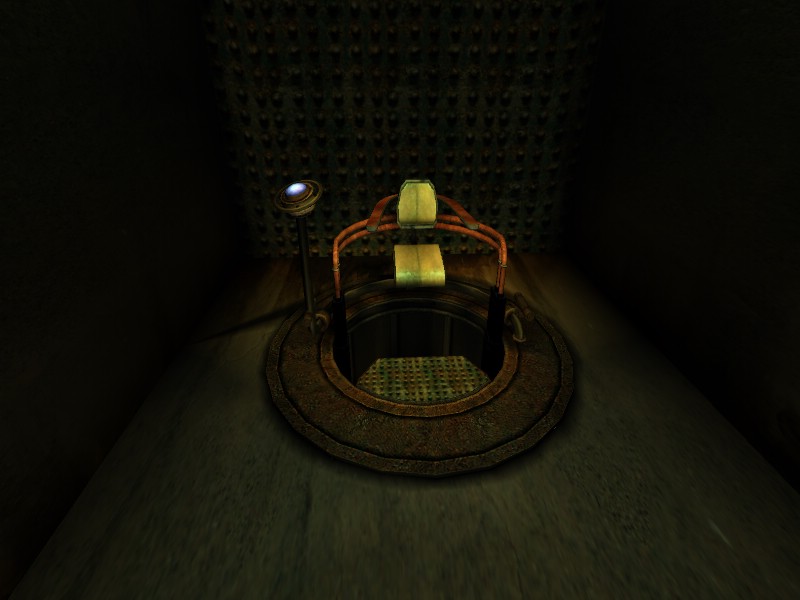 The
"vogondola" is the nickname of the magnetic levitation vehicle
used to transfer a passenger between the orborbitor and Kādish's
office. It travels from the sphere machine to a cage with sails on it
and then across a gap to another mag-lev track. It terminates below
the office, which was excavated into a rock spire. |
 The vogondola track is made up of electromagnetic rings and bars, and
the car is suspended between them. The vogondola track is made up of electromagnetic rings and bars, and
the car is suspended between them.
The track extends from just below Kādish's office and up to the
central hub that the spheres rotate around.
|
 Perhaps
because electricity and water don't play well together, Kādish
used another method for the part of the journey that passed alongside
the cascade. Perhaps
because electricity and water don't play well together, Kādish
used another method for the part of the journey that passed alongside
the cascade.
That section of the track has a cage with a large sail attached
to it. The vogondola car enters the cage, which then closes around
it and supports it. The cage probably gets a push magnetically to start
it on its way, but it appears that downdraft air currents
are used to move it across the gap while suspended from an overhead cable.
When the cage reaches
the electromagnetic track on the other side, the opposite side opens and the
vogondola is picked up by the magnetism of the next section of track and conveyed to its end.
|
The Office
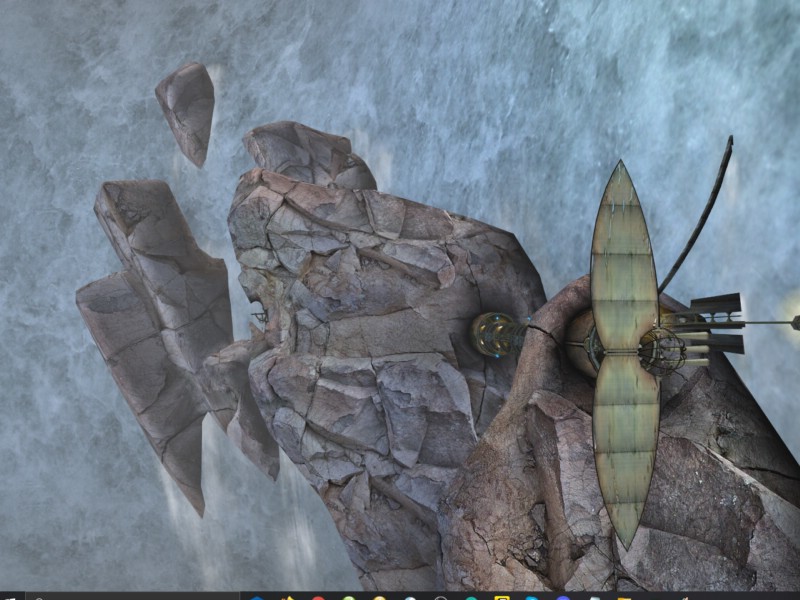 The office is inside a large rock outcrop where it is protected from
the water. |
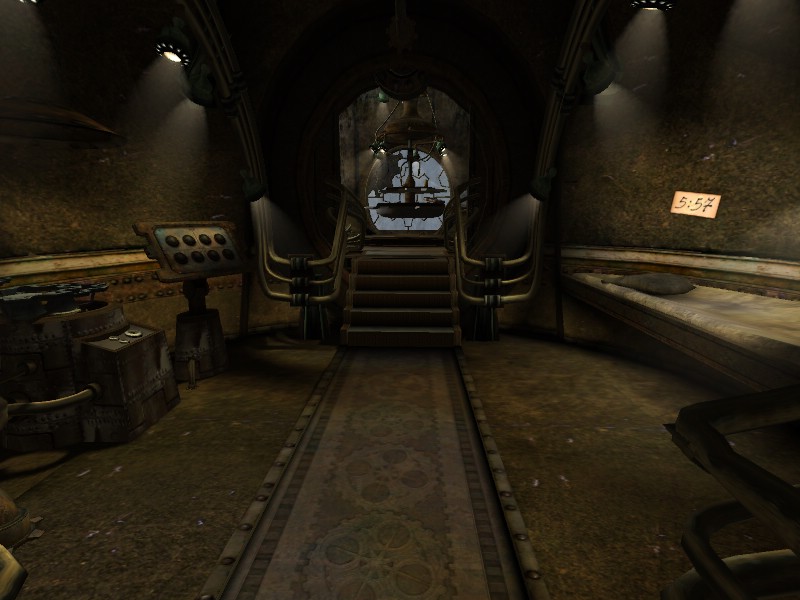 The antechamber of the office was used as sleeping quarters
when Kādish was working in the Age. The purpose of the machine to the immediate
left has not yet been explained. The second machine is the locking mechanism
for the door to the office. The antechamber of the office was used as sleeping quarters
when Kādish was working in the Age. The purpose of the machine to the immediate
left has not yet been explained. The second machine is the locking mechanism
for the door to the office.
Note the paper pasted to the wall with the
number 5:57 written on it. That was one of the clues to the Path of the
Shell left by Yeesha which refers to a verse in Words. |
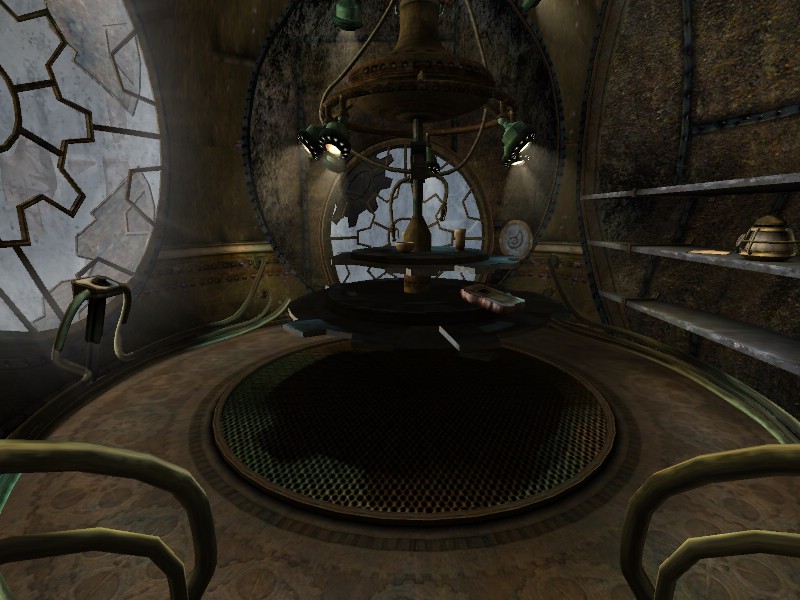 The final room was Kādish's office in the Age. The Bahro stone tablet was
placed here by Yeesha for her version of the Path of the Shell, and
links to the Bahro hourglass cave. |
The Orborbitor
 The machine the spheres are mounted on is the dominant feature of the Age. The machine the spheres are mounted on is the dominant feature of the Age.
The machine’s proper name
is “the
orborbitor”, which is suspected to be a nickname given to it by the DRC.*
In this picture, you can see the vogondola track terminating
in the central hub. The maintenance rooms are located in the cross arms
although only the active one lines up with the hatch into the hub room. |
 The mechanism of the orborbitor involves escapements and other clockwork designs. The primary source
of the power needed to rotate the spheres is this waterwheel.* |
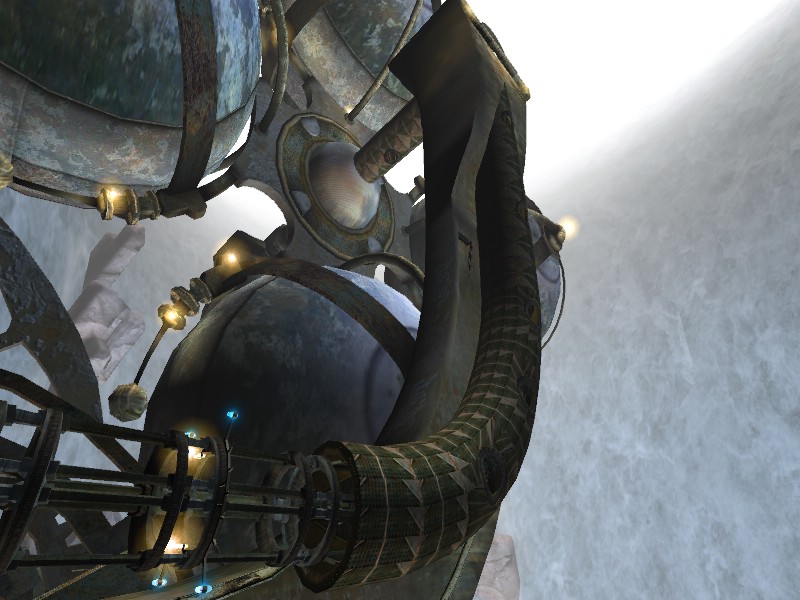 It's
unknown which of the two spheres on the horizontal plane is the active
one. It could be either since they are not marked on their
exteriors. It's
unknown which of the two spheres on the horizontal plane is the active
one. It could be either since they are not marked on their
exteriors.
(OOC note: The Orborbitor was never intended to be seen from such
a short distance, so there are several design faults. The orbs are
too small to contain the interiors we see, the cross-arms are too narrow
to hold the maintenance rooms, and there's a gap between the spheres
and the cross-arms that shouldn't be there. We just have to pretend
not to see them. As Oz the Great and Terrible once said, "Pay no attention
to that man behind the curtain!"
|
|




 The
DRC called this hall the Cathedral because of its architecture, not
because it had any religious purpose.
The
DRC called this hall the Cathedral because of its architecture, not
because it had any religious purpose. The
First Sphere: The first sphere was nicknamed "Water
Ahnonay" by explorers. It is supposed to be the Garternay of the past,
when the Ronay lived there.
The
First Sphere: The first sphere was nicknamed "Water
Ahnonay" by explorers. It is supposed to be the Garternay of the past,
when the Ronay lived there. The
only living creatures seen in the first sphere are curious little arthropods
called quabs. Quabs are natives of the Age of
Ahnonay who found their way into the sphere in the centuries
since the Fall of D'ni.*
The
only living creatures seen in the first sphere are curious little arthropods
called quabs. Quabs are natives of the Age of
Ahnonay who found their way into the sphere in the centuries
since the Fall of D'ni.*  In
this picture is the only type of tree
to be found on the land in the sphere. An early explorer dubbed
them "terrose" trees,
from the D'ni word "ter",
meaning tree, and the English word "rose" because of the color of their
leaves.
In
this picture is the only type of tree
to be found on the land in the sphere. An early explorer dubbed
them "terrose" trees,
from the D'ni word "ter",
meaning tree, and the English word "rose" because of the color of their
leaves. Ahnonay is not the only place that an explorer can find trees like these. There is a variety with the same characteristics but with green leaves found in the Age of Releeshan.
Ahnonay is not the only place that an explorer can find trees like these. There is a variety with the same characteristics but with green leaves found in the Age of Releeshan. In
the lagoon surrounded by the main island is a clock tower. It also
served a second, secret purpose; it's a sophisticated pressure guage
that Kādish used to check if any extra weight was on either of
the two main islands.
In
the lagoon surrounded by the main island is a clock tower. It also
served a second, secret purpose; it's a sophisticated pressure guage
that Kādish used to check if any extra weight was on either of
the two main islands.
 The smaller island held controls for Water Ahnonay,
inside a structure that could not be opened from the outside. Kādish
probably had a private linking book to get to its interior, which Yeesha
would have removed when she set up her version of the Path of the Shell
quest.
The smaller island held controls for Water Ahnonay,
inside a structure that could not be opened from the outside. Kādish
probably had a private linking book to get to its interior, which Yeesha
would have removed when she set up her version of the Path of the Shell
quest. Kādish
designed pumps that created fierce currents to keep people from discovering
the trickery in the sphere. Inside the tower is a large valve that
controls the water currents, allowing him to turn them off and inspect
the sphere when there were no visitors.
Kādish
designed pumps that created fierce currents to keep people from discovering
the trickery in the sphere. Inside the tower is a large valve that
controls the water currents, allowing him to turn them off and inspect
the sphere when there were no visitors.
 This
room is called Maintenance Room One. There are individual maintenance
rooms for each of the four spheres.
This
room is called Maintenance Room One. There are individual maintenance
rooms for each of the four spheres. The
Second Sphere: Sphere number two was nicknamed Misty
Ahnonay by explorers. It was meant to represent Garternay in the present.
As with sphere 1, the grass found here in an invasive species from
the outside world.
The
Second Sphere: Sphere number two was nicknamed Misty
Ahnonay by explorers. It was meant to represent Garternay in the present.
As with sphere 1, the grass found here in an invasive species from
the outside world. When
you first see this sphere, it contains crystalline structures. Early
explorers dubbed them "ning" trees, because they resemble lightning
bolts in shape.
When
you first see this sphere, it contains crystalline structures. Early
explorers dubbed them "ning" trees, because they resemble lightning
bolts in shape. The
tower in this sphere had little purpose for Kādish except continuity.
While he built the same internal framework inside it, it was bare of
anything else.
The
tower in this sphere had little purpose for Kādish except continuity.
While he built the same internal framework inside it, it was bare of
anything else.  The
control room in this sphere served no active purpose for Kādish.
Yeesha, on the other hand, used it as a journey station. Kādish
would have accessed it from the hub room.
The
control room in this sphere served no active purpose for Kādish.
Yeesha, on the other hand, used it as a journey station. Kādish
would have accessed it from the hub room.  The Third Sphere: The third sphere was nicknamed Space
Ahnonay by explorers. Kādish told visitors that it was Garternay in the future.
He probably also told them that it was his powers as the Grower that were
providing them with air to breathe.
The Third Sphere: The third sphere was nicknamed Space
Ahnonay by explorers. Kādish told visitors that it was Garternay in the future.
He probably also told them that it was his powers as the Grower that were
providing them with air to breathe. One
of the most prominent features of the sphere are the rings around the
island.
One
of the most prominent features of the sphere are the rings around the
island. The
ring system shown here isn't completely impossible, as outlandish as
it might seem. In the Solar system, there is an object that has been
classed as either a large asteroid or a minor planet named Chariklo
and it has two rings around it. It's 250 km or 160 miles
in diameter, and is the smallest known celestial body to have a ring
system.
The
ring system shown here isn't completely impossible, as outlandish as
it might seem. In the Solar system, there is an object that has been
classed as either a large asteroid or a minor planet named Chariklo
and it has two rings around it. It's 250 km or 160 miles
in diameter, and is the smallest known celestial body to have a ring
system. The
Fourth Sphere: The interior of the fourth sphere was not
completed before D'ni fell, but it's pretty obvious that was going to
be Kādish's
monument to himself.
The
Fourth Sphere: The interior of the fourth sphere was not
completed before D'ni fell, but it's pretty obvious that was going to
be Kādish's
monument to himself. The
statue is, of course, a likeness of Kādish. It's covered in
geometric shapes and numbers. If you look down at the base of the statue,
there are gears and wheels that appear to have been intended to
move the statue in some manner. It probably revolved, but the other gears
appear to have allowed it to tilt back and forth.
The
statue is, of course, a likeness of Kādish. It's covered in
geometric shapes and numbers. If you look down at the base of the statue,
there are gears and wheels that appear to have been intended to
move the statue in some manner. It probably revolved, but the other gears
appear to have allowed it to tilt back and forth.  The
maintenance room for this sphere is the only one that allows access into
the central hub.
The
maintenance room for this sphere is the only one that allows access into
the central hub.  This
is the inside hatch, which closes off the hub room.
This
is the inside hatch, which closes off the hub room. Other
depictions: In Eder Kēmo, there are bahroglyphs representing
Ahnonay in a seating area near the Puffer garden. One of the unanswered
questions about the glyphs involved a species of fish seen in them.
Other
depictions: In Eder Kēmo, there are bahroglyphs representing
Ahnonay in a seating area near the Puffer garden. One of the unanswered
questions about the glyphs involved a species of fish seen in them. This
area is inside the cetral hub the four spheres revolve around.
Now we begin to see why gears are a decorative motif for the Age. Many
gears of immense size are used to rotate the spheres.
This
area is inside the cetral hub the four spheres revolve around.
Now we begin to see why gears are a decorative motif for the Age. Many
gears of immense size are used to rotate the spheres. The
large viewer shows the interior of the sphere which is in the "active" position.
The
large viewer shows the interior of the sphere which is in the "active" position. The
"vogondola" is the nickname of the magnetic levitation vehicle
used to transfer a passenger between the orborbitor and Kādish's
office. It travels from the sphere machine to a cage with sails on it
and then across a gap to another mag-lev track. It terminates below
the office, which was excavated into a rock spire.
The
"vogondola" is the nickname of the magnetic levitation vehicle
used to transfer a passenger between the orborbitor and Kādish's
office. It travels from the sphere machine to a cage with sails on it
and then across a gap to another mag-lev track. It terminates below
the office, which was excavated into a rock spire. The vogondola track is made up of electromagnetic rings and bars, and
the car is suspended between them.
The vogondola track is made up of electromagnetic rings and bars, and
the car is suspended between them. Perhaps
because electricity and water don't play well together, Kādish
used another method for the part of the journey that passed alongside
the cascade.
Perhaps
because electricity and water don't play well together, Kādish
used another method for the part of the journey that passed alongside
the cascade. The office is inside a large rock outcrop where it is protected from
the water.
The office is inside a large rock outcrop where it is protected from
the water. The antechamber of the office was used as sleeping quarters
when Kādish was working in the Age. The purpose of the machine to the immediate
left has not yet been explained. The second machine is the locking mechanism
for the door to the office.
The antechamber of the office was used as sleeping quarters
when Kādish was working in the Age. The purpose of the machine to the immediate
left has not yet been explained. The second machine is the locking mechanism
for the door to the office. The final room was Kādish's office in the Age. The Bahro stone tablet was
placed here by Yeesha for her version of the Path of the Shell, and
links to the Bahro hourglass cave.
The final room was Kādish's office in the Age. The Bahro stone tablet was
placed here by Yeesha for her version of the Path of the Shell, and
links to the Bahro hourglass cave.  The machine the spheres are mounted on is the dominant feature of the Age.
The machine the spheres are mounted on is the dominant feature of the Age. The mechanism of the orborbitor involves escapements and other clockwork designs. The primary source
of the power needed to rotate the spheres is this waterwheel.*
The mechanism of the orborbitor involves escapements and other clockwork designs. The primary source
of the power needed to rotate the spheres is this waterwheel.* It's
unknown which of the two spheres on the horizontal plane is the active
one. It could be either since they are not marked on their
exteriors.
It's
unknown which of the two spheres on the horizontal plane is the active
one. It could be either since they are not marked on their
exteriors.